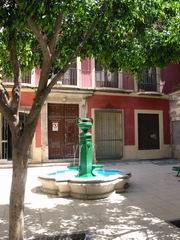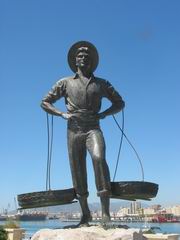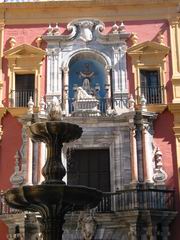Phoenicians, Greeks, Carthaginians, Romans... the major Mediterranean civilizations more than two thousand years ago found in Málaga an exceptional site to establish trade routes, thanks to the strategic position of its port. The Citadel (8th-11th centuries) is, as well as one of the city's symbols, one of the largest Arab fortresses in Andalusia. The Archaeological Museum is located in this building, which contains valuable pieces from the Phoenician and Roman periods.
The Castle of Gibralfaro (14th century), joined to the Citadel by a stretch of wall, gives the best views of the city, which opens out onto the sea with the port and the promenade of La Farola, one of the major leisure areas in the city. At the foot of Gibralfaro is the Roman Theatre, the bullring (known as "La Malagueta") and the historic quarter of the city.



In the centre stands the Cathedral (16th-18th centuries), also known as “la Manquita” because of its unfinished right tower. This temple, beautifully executed in the Renaissance style, preserves an interesting series of chapels which contain fine examples of Andalusian images. In the old town, other prominent churches are Santiago (15th-18th centuries), with a beautiful Mudejar tower, los Mártires, Sagrado Corazón and Santo Cristo de la Salud.
Historic Málaga offers countless spots and corners full of local colour. The façade of the City Hall, from the early 20th century, can be admired, as can the Merced square, dominated by the Monument to Torrijos and where the house in which the famous painter Pablo Ruiz Picasso was born is situated. A tour of the historic quarter must take in the busy Pasaje de Chinitas, calle Granada, with the Fine Arts Museum, or calle Larios, the old town's main thoroughfare.
Málaga provincial capital also has extensive green areas, such as the Park, the Alameda Principal, the gardens of Puerta Oscura and Pedro Luis Alonso.
But a visit to the centre of the city is not all we recommend. It is also worth taking in and getting a taste of the flavour of everyday life in the different adjacent neighbourhoods, such as El Perchel, El Egido or La Trinidad.
Map of Málaga
{mosmap width='500'|height='400'|address='Málaga Spain'| zoom='14'|zoomType='Large'|zoomNew='0'|mapType='Map'|traffic='1'|showMaptype='0'| overview='0'|tooltip='DWO'|marker='0'| align='center'-}
or a PDF map of Málaga for download clicking here
Gastronomy, festivals and surrounding area
A good time to visit Málaga is during Holy Week. This festival, declared in Málaga to be of International Tourist Interest, stands out because of its tremendous floats and the popular fervour it arouses in each neighbourhood. One of the best options for accomodation in Málaga is the Parador de Málaga Gibralfaro, located next to the Castle. It is a good idea, however, to book well ahead at this time of year.
The surrounding area of Málaga invites you to tour a province marked by sharp contrasts between the towns inland and those on the coast.The Costa del Sol is dotted with towns of considerable tourist tradition, such as Benalmádena, Torremolinos, Fuengirola, Marbella or Estepona. It is also possible on this stretch of coast to enjoy hotel establishments such as the Parador de Málaga Golf or its sister establishment in Nerja.
Golf lovers have an extra incentive to visit Málaga, since it has some thirty courses scattered around the entire province, some of which are ranked among the best in Europe.
There are several natural spaces in the provinces's interior, such as Alcornocales-Sierra del Aljibe Nature Reserve, the Montes de Málaga Nature Reserve or the Sierra de las Nieves Nature Reserve. The paradors of Ronda and Antequera stand out among the hotels available in the province's interior. Products from the sea and inland give rise to a rich and varied gastronomy. On the coast, the most famous dish is “pescaíto frito” (fried fish), although also typical, among others, are seafood rice, monkfish with potatoes and noodle casserole.
Soups occupy an important place in Málaga's cuisine, with specialities such as "gazpachuelo" (soup made from potatoes and mayonnaise) and "gazpacho malagueño" or "ajoblanco" (a kind of cold soup with almonds, oil, garlic and grapes). These dishes can be accompanied by the wines with Designation of Origin Málaga status.
For dessert, the choice includes sweet potato (roasted or covered in syrup), oil pancakes or raisins from Axarquía
Places to be visited
- Museo Picasso
- Casa natal de Picasso
- Museo Carmen Thyssen Telf: 902 303131
- Museo Alcazaba (Málaga)tel. +34 952227230
- Catedral de Málaga (Málaga) tel. +34 952215917
- Teatro romano de Málaga (Málaga) tel. +34 951041400
Where to eat
Adolfo €€€
Paseo Maritimo Pablo Ruiz Picasso, 12
Teléfono : 952.60.19.14
Dani García (Old Antonio Martín) €€
Pza. de la Malagueta, s/n
Teléfono : 95 222 73 82
Cañadú €€
Pza. de la Merced, 21
zona : Centro
Teléfono : 95.222.90.56
Vegetarian
Circus €€
P.º de Reding, 41
Málaga
Teléfono : 95 222 00 85
Pizza & Pasta
Clandestino €€
Calle Niño de Guevara Nº: 3
Málaga
zona : Centro
Tef. 952 219 390
Where to sleep
- Hotel IBIS (**) Pasillo Guimbarda 5, Tel: (+34)952/070741
- Hotel del Pintor C/ Álamos 27 Tel: (+34)952060980
- Tryp Alameda (****) Centro Comercial Larios. Avda. de la Aurora, 25
- Tryp Guadalmar (****) Calle Moby Dick, 2, Tel: (+34)952231703
- Hotel La Chancla Paseo Maritimo (El Pedregal), 64, Malaga Telf (+34) 952 206 900
- AC Málaga Palacio Cortina del Muelle, 1, Málaga - 952 215 185
- Meliá Costa del Sol (****). Paseo Marítimo El Bajondillo.Torremolinos Tel: 952 386 677.
Tourist information:
Plaza de Blas Infante, 1. 29620.
Phone: 952 379 511 Fax: 952 379 551







